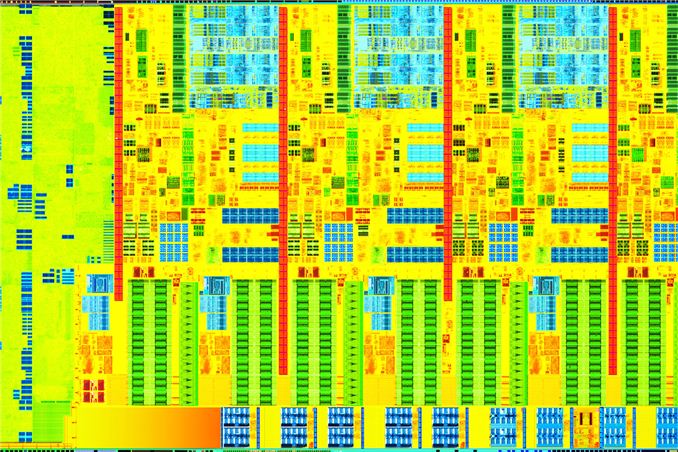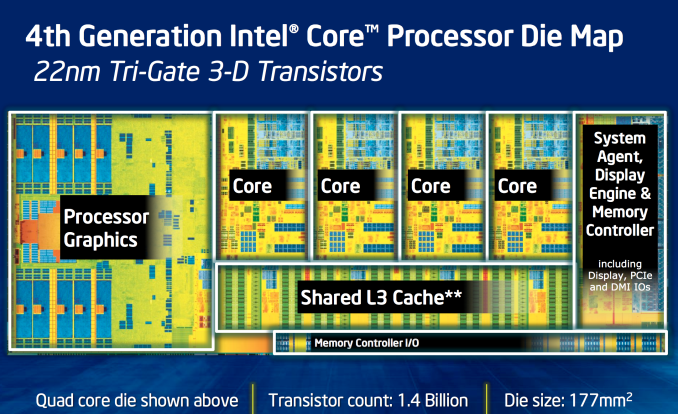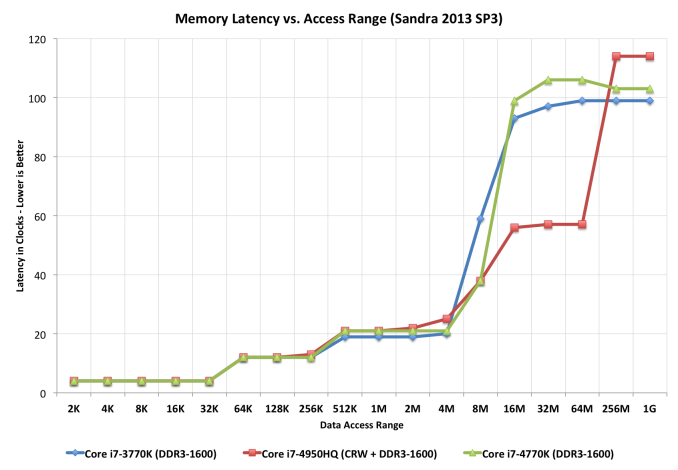The Haswell Review: Intel Core i7-4770K & i5-4670K Tested
by Anand Lal Shimpi on June 1, 2013 10:00 AM EST
This is a very volatile time for Intel. In an ARM-less vacuum, Intel’s Haswell architecture would likely be the most amazing thing to happen to the tech industry in years. In mobile Haswell is slated to bring about the single largest improvement in battery life in Intel history. In graphics, Haswell completely redefines the expectations for processor graphics. There are even some versions that come with an on-package 128MB L4 cache. And on the desktop, Haswell is the epitome of polish and evolution of the Core microprocessor architecture. Everything is better, faster and more efficient.
There’s very little to complain about with Haswell. Sure, the days of insane overclocks without touching voltage knobs are long gone. With any mobile-first, power optimized architecture, any excess frequency at default voltages is viewed as wasted power. So Haswell won’t overclock any better than Ivy Bridge, at least without exotic cooling.
You could also complain that, for a tock, the CPU performance gains aren’t large enough. Intel promised 5 - 15% gains over Ivy Bridge at the same frequencies, and most of my tests agree with that. It’s still forward progress, without substantial increases in power consumption, but it’s not revolutionary. We compare the rest of the industry to Intel’s excellent single threaded performance and generally come away disappointed. The downside to being on the top is that virtually all improvements appear incremental.
The fact of the matter is that the most exciting implementations of Haswell exist outside of the desktop parts. Big gains in battery life, power consumption and even a broadening of the types of form factors the Core family of processors will fit into all apply elsewhere. Over the coming weeks and months we’ll be seeing lots of that, but today, at least in this article, the focus is on the desktop.
Haswell CPU Architecture Recap
Haswell is Intel’s second 22nm microprocessor architecture, a tock in Intel’s nomenclature. I went through a deep dive on Haswell’s Architecture late last year after IDF, but I’ll offer a brief summary here.
At the front end of the pipeline, Haswell improved branch prediction. It’s the execution engine where Intel spent most of its time however. Intel significantly increased the sizes of buffers and datastructures within the CPU core. The out-of-order window grew, to feed an even more parallel set of execution resources.
Intel added two new execution ports (8 vs 6), a first since the introduction of the Core microarchitecture back in 2006.
On the ISA side, Intel added support for AVX2, which includes an FMA operation that considerably increases FP throughput of the machine. With a doubling of peak FP throughput, Intel doubled L1 cache bandwidth to feed the beast. Intel also added support for transactional memory instructions (TSX) on some Haswell SKUs.
The L3 cache is now back on its own power/frequency plane, although most of the time it seems to run in lockstep with the CPU cores. There appears to be a 2 - 3 cycle access penalty as a result of decoupling the L3 cache.


















210 Comments
View All Comments
IUU - Thursday, June 6, 2013 - link
These are some very good processors. What is misplaced though is the graphics part. It is ok for mobile processors to have such a part, but for high energy consuming desktop processors, it is irrelevant and more of a burden. In the desktop world you expect a cpu with the highest possible processing power. It is 2013 and quad core is kind of old, come on intel don't be shy bring 8 and 10 core processors, you have the room to accommodate it. If I want graphics I 'll buy a monster graphics chip and will not be bothered by "optimal" power consumption.It is sad to see the energy efficiency and the computing efficiency improving only to accommodate a miserable graphics card. If you want us to buy graphics together with the cpu(an apu) make a chip with a tdp 300-400 because this is a mainstream energy budget for the desktop.
If it is impractical(which is probably the case) build your own discrete graphics.
Don't vandalize your cpus this way. If you want the mobile go for it, just don't contaminate your desktop products.
desky - Saturday, June 8, 2013 - link
same with me!I'm currently running an E8400@4,5GHz since 2008, and now seems a good time to upgrade.
I hope the haswell chip will overclock just as good. From what I've read that means that I may have to exchange the thermal paste under the IHS for some coolaboratory stuff...
Not decided on i5 or i7 yet though...
cmdrdredd - Monday, June 3, 2013 - link
You shouldn't have expected a reason to upgrade yet. Sheesh...we knew it would not be a real upgrade over an SB or IB CPU.peckiro - Monday, June 3, 2013 - link
I built a new from the case up Z77 rig with a 3570K processor running 24/7 @ 4.4GHz last fall. I seriously considered waiting for Haswell to hit the market before upgrading my machine (circa 2007). I'm glad I didn't wait any longer since, I have been running a damned fast machine for 8 months now. I think I may have felt perhaps a little bit underwhelmed if I had waited for Haswell. Just my 2 cents worth.cmdrdredd - Monday, June 3, 2013 - link
Yep...I built up my current 3570k system around the summer last yearyearkaiserreich - Saturday, June 1, 2013 - link
While you are right that load power consumption is higher, the system is not loaded all the time.Not for the common users any way. In that case, idle will serve as a better power performance indicator as opposed to load consumption.
tential - Saturday, June 1, 2013 - link
Pulling up this website and browsing my CPU utilization is under 20% and under 10-5% the majority of the time. Now I'm 5 years back on a Core2Duo. I'd imagine by now, if I was browsing this page on a Haswell, it'd be even lower considering processors are much faster as well. So mobile side I'm guessing that average battery life increased quite a bit. We'll see with the review. Using LOAD power consumption to judge mobile though is just plain ignorant.This is why some people need to stick to reading reviews, and wait for full reviews come out, rather than jumping to early conclusions and misinterpreting information.
t.s - Sunday, June 2, 2013 - link
So, what about people that want to gaming on laptop?takeship - Sunday, June 2, 2013 - link
Did you realize that these are all desktop chips? Let's not judge using desktop parts. But seriously, what percentage of users game with a mobile quad core & intel graphics?krumme - Saturday, June 1, 2013 - link
5-10% is on the positive side imho.http://www.guru3d.com/articles_pages/core_i7_4770k...
Sometimes it can even be slower :)
This processor is not intented for desktop. There is nothing wrong in that. But why all this bs covering it. Its a fine processor and a weird and shallow review.